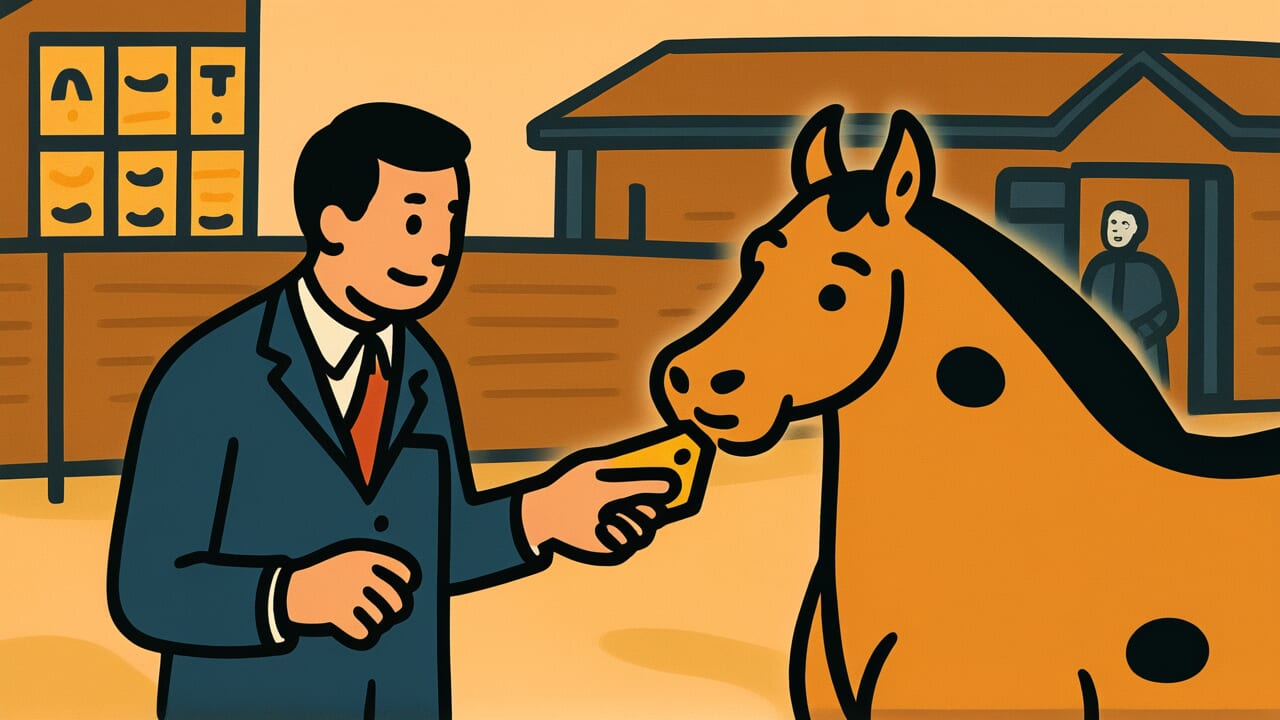How to Read “When wanting to buy a horse, first ask about cattle”
Uma wo kawan to hoshite mazu ushi wo tou
Meaning of “When wanting to buy a horse, first ask about cattle”
This proverb teaches that to achieve your goal, you should first learn the related basics thoroughly. If you want to buy an expensive horse, don’t jump straight into horse trading. Instead, ask about more familiar cattle first and build your general knowledge about livestock.
People use this saying when advising someone who wants to tackle something specialized. It emphasizes the importance of learning from the ground up. For example, you might use it when telling someone who wants to master advanced skills to polish their basic abilities first.
This expression works well because it uses concrete imagery to show that what seems like a roundabout learning method is actually the most reliable path. Even today, success in any specialized field requires solid foundational knowledge.
The proverb teaches practical wisdom. Don’t rush toward your goal impatiently. Instead, build a strong foundation first. This approach has lasting value.
Origin and Etymology
The exact source of this proverb remains debated, but scholars suggest it may have been influenced by classical Chinese thought. Expressions contrasting horses and cattle have appeared throughout East Asian cultures since ancient times.
Let’s examine the structure of the phrase. “When wanting to buy a horse” expresses the goal of obtaining an expensive, superior horse. Horses were historically important for transportation and military power. Good horses sold for high prices.
Meanwhile, “first ask about cattle” refers to cattle, the familiar livestock essential for farming. Cattle weren’t as glamorous as horses, but they were closely connected to people’s daily lives.
This contrast carries deep meaning. Before making the specialized, advanced judgment of buying a horse, you learn about the more familiar and basic cattle. You study cattle breeding methods, how to judge health conditions, and how to determine fair prices.
By gaining foundational knowledge applicable to livestock in general, you also develop an eye for evaluating horses. This proverb expresses the importance of learning step by step through the relationship between these two animals.
People have passed down this saying as practical wisdom. It captures the essence of learning and connects to the spirit of “more haste, less speed.”
Usage Examples
- If you want to start programming, remember “when wanting to buy a horse, first ask about cattle” and learn basic computer operations first
- Before rushing to make money through investing, I’ll study economics fundamentals with the spirit of “when wanting to buy a horse, first ask about cattle”
Universal Wisdom
Humans have a tendency to become captivated by brilliant goals and neglect steady preparation. This proverb has been passed down through generations precisely because it sees through this essential human nature.
We tend to fixate on the glamorous aspects of success. Excellent skills, high positions, great achievements. It’s natural to admire these “horses.” However, behind that brilliance always lies the steady accumulation of basics. That’s the “cattle.”
What’s interesting is that this proverb says “ask about cattle,” not “learn cattle.” To ask means to inquire humbly and request teaching. In other words, when learning basics, you must acknowledge your ignorance and maintain a sincere learning attitude.
Everyone feels impatient to achieve results quickly. But our ancestors knew something important. Those who rush to reach heights most often find themselves on unstable ground. Without a foundation of basics, even the tallest building will collapse.
This proverb contains both a harsh truth and hope. The truth is that there are no shortcuts to success. The hope is that if you walk steadily, you will definitely reach your goal. This reflects deep understanding of and kindness toward humanity that transcends time.
When AI Hears This
In telecommunications engineering, we deliberately add extra information when sending data. For example, when sending 4 bits of data like “1001,” we add 3 bits to make “1001011.” We call these additions redundant bits.
They seem wasteful at first glance. But they allow the receiver to verify the data isn’t corrupted and correct any errors.
“When wanting to buy a horse, first ask about cattle” works exactly like these redundant bits. When you ask about cattle prices, breeding costs, disease risks, and feed expenses, you gain perspective on the entire livestock market.
You’re collecting “reference data” that you couldn’t get from horse information alone. If a seller inflates the horse’s price, you can notice “this price is wrong” by comparing it to cattle. This is error detection in information theory.
In practice, Hamming code error correction adds 3 redundant bits to 4 data bits, allowing automatic correction of 1-bit errors. The redundancy reaches 43 percent, but this “waste” guarantees accuracy.
The seemingly roundabout act of asking about cattle serves the same role for the goal of buying a horse. Redundancy in the form of peripheral information functions as error-correcting code that prevents judgment mistakes.
Lessons for Today
Modern society strongly values instant results, and we’re tempted to look for shortcuts. But this proverb teaches us something important. If you want to obtain something truly valuable, you need the courage to learn from the basics without rushing.
If you’re trying to challenge yourself with something new right now, ask yourself this question. Do you understand the basics of that field? Do you have related knowledge?
If the answer is “no,” that’s nothing to be ashamed of. In fact, being able to start from there is fortunate.
Today, information overflows and we can access specialized knowledge immediately. But precisely because of this, the temptation to skip basics and move ahead becomes stronger. That’s when you should remember this proverb.
Time spent learning basics is never wasted. It strengthens your foundation and becomes an investment supporting your future growth. The path that seems like a detour is actually the most reliable route to your goal.
Don’t rush. Take it one step at a time. That attitude is what cultivates real strength.



Comments